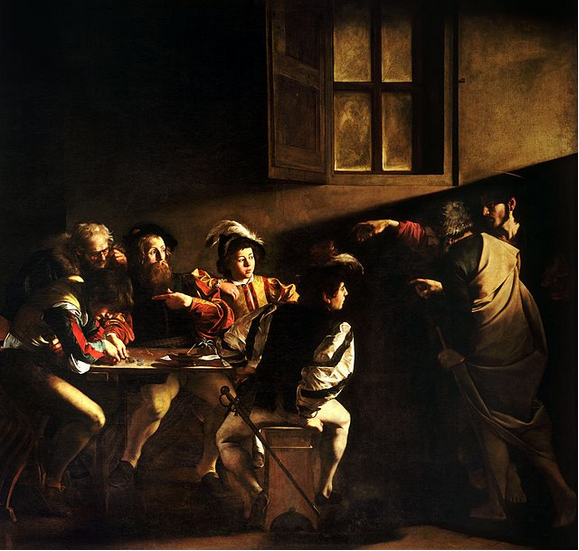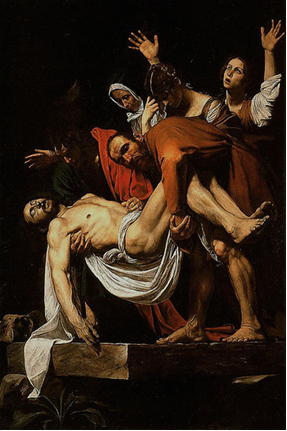Nowadays, Michelangelo Merisi da Caravaggio (1571-1610) is being commonly referred to as the founder of Baroque style in visual art (Charles and Klaus 43). Such a point of view is fully justified – something that can be easily illustrated, in regards to the essence of what can be identified as the clearly defined baroque-related themes and motifs, contained in his paintings, and also, in regards to the fact that, in this respect, Caravaggio proved himself nothing short of an ‘artistic revolutionary’.
Before proceeding to illustrate the validity of this suggestion, in relation to at least two of the artist’s paintings, we will need to identify what were the main preconditions, behind the emergence of baroque style in the domain of visual art, and to outline this style’s foremost characteristics.
The emergence of this particular style has been triggered by the fact that, in the aftermath of the heliocentric concept of the universe having proven fallacious (thanks to Copernicus), many intellectually advanced people in Europe began to experience the sensation of disillusionment with what they used to believe the universe was all about.
At the same time, the Catholic Church decided to apply an ‘aesthetic’ effort, within the context of opposing Protestant Reformation – mainly, by the mean of encouraging artists to explore Biblical fables in the emotionally/psychologically sound manner (Bohn and Saslow 165). In its turn, this created the objective preconditions for baroque style in visual arts to be closely associated with the following qualitative features:
- Theatricalness – as a rule, the compositional details of baroque paintings emphasize the emotional intensity of what is being depicted (Bucci-Glucksmann and Baker 6).
- Dynamism – the depicted scenes in baroque paintings are always highly dynamic. This explains why there is a certain ‘photographic’ quality to these paintings – while being exposed to them; one gets a ‘snapshot’ of the spatially prolonged action.
- Attention to detail – in the visual sense of this word, baroque paintings are highly detailed.
- Representational whimsicalness – in baroque paintings, the featured scenes’ participants are usually shown in the manner that parts away with the Renaissance conventions of aesthetic appropriateness (Conti and Gozzoli 62).
- Colorfulness/Realism – baroque paintings are brightly colored and feature the representational elements of Realism.
- Visual innovativeness – baroque artists strive to utilize the representational interaction between light and shadow as the mean of increasing the psychological plausibility of the depicted scene’s themes and motifs.
- Asymmetry – the compositional elements in baroque paintings are proportionally misbalanced.
The validity of the earlier mentioned insights, into what accounts for the main qualitative characteristics of the baroque style, can be well confirmed, in regards to Caravaggio’s work The Calling of St. Matthew:

The reason for this is that, as can be seen above, in this particular painting, the representational subtleties of baroque style can be identified with ease.
What instantly comes in one’s sight, in this respect, is that Caravaggio made a deliberate point in ensuring that the depicted scene is being illuminated from a somewhat unconventional angle, which in turn creates a strong dramatic effect, ensued by the resulting contrast between light and darkness (Prendeville 189). Apparently, the author wanted to literalize the validity of the assumption that Jesus, in fact, embodies light.
Another clearly notable indication of this particular painting is closely affiliated with the style baroque is that one of the featured characters is shown sitting backwards. In its turn, this adds to the measure of this painting’s perceptual spontaneity – hence, making the depicted fable thoroughly believable in the eyes of spectators.
The reason for this is that, due to the above-mentioned, viewers are being prompted to think of The Calling of St. Matthew in terms of a thoroughly trustful account of how Jesus turned St. Matthew into one of his disciples.
The fact that The Calling of St. Matthew is indeed a baroque painting can also be illustrated in relation to the emotional plausibility of the featured characters’ facial expressions. For example, while exposed to the character of St. Matthew, one will inevitably come to conclude that, just as it was mentioned in the Bible, this would-be Apostle could not accept the fact that he was chosen by Jesus, right down to the last moment. The reason for this is that this individual’s face radiates the expression of genuine amazement.
This, of course, contributes even further towards legitimizing the concerned painting, as such that belongs to the style baroque – baroque artists never ceased emphasizing what happened to be the emotional state of the characters that they chose to portray.
Another Caravaggio’s painting, which can be referred to as such that contains a number of clues, as to what baroque style is all about, is The Entombment of Christ:

This simply could not be otherwise – just as it happened to be the case with the earlier analyzed painting, there are a number of the clearly defined baroque elements to it. For example, the character of Mary Magdalene in the painting’s upper-right corner is shown throwing her hands up – an unmistakably theatrical gesture, meant to accentuate the depicted scene’s dramatic overtones.
There is also a compositional misbalance to this particular painting. As can be seen above, the scene’s actual ‘mass’ is shifted towards the corner with Mary Magdalene in it, which in turn creates the impression that there is some elusive movement is taking place in this direction. In all probability, the reason why Caravaggio decided in favor of constructing the painting’s composition in the way he did, is that it prompts viewers to believe that, after having left its body, Jesus’ soul flew straight into the ‘kingdom of heaven’ (Joncas 40).
The Entombment of Christ is a thoroughly realistic artwork. One will be able to confirm the validity of this suggestion with ease, in regards to the appearance of Jesus’ dead body. First – it is utterly pale. Second – it seems like those two persons who hold his body do experience a somewhat hard time while dealing with the body’s sheer weight. This, of course, is meant to confirm the validity of the assumption that, in the aftermath of his crucifixion, Jesus did die – at least in the physical sense of this word.
Finally, we can well mention the fact that The Entombment of Christ is an utterly dynamic painting. The reason for this is quite apparent – as a result of having been exposed to it, just about anyone will be able to confirm that what it is being depicted in it, is a dynamic process (entombment) and not a spatially stable condition. Partially, the mentioned effect has been achieved by the facial expression of the character who holds Jesus by his legs – he appears to be fully aware of the sheer gravity of what had happened to the Savior.
Thus, it will be indeed fully appropriate to refer to Caravaggio, as the founder of Baroque style in visual art. After all, at the end of the 16th century (when Caravaggio produced most of his works), the earlier mentioned stylistic particulars of how the author used to go about exploring his creative genius, were considered utterly innovative.
Partially, this explains why, even though the themes and motifs of most of Caravaggio’s paintings are essentially religious, his works have always been appreciated by secularly minded people so much more, as compared to what it used to be the case with the members of the Catholic clergy.
Annotated Bibliography
Bohn, Babette, and James Saslow. Companion to Renaissance and Baroque Art. Hoboken: Wiley, 2013. Print.
In their book, Babette and Saslow compare the artistic styles of Renaissance and Baroque, while suggesting that, even though there is indeed much in common between them, both styles remain rather inconsistent in a variety of different ways. The main idea, promoted throughout the book’s entirety, is that whereas the former style is thoroughly optimistic, the latter one draws heavily on the sensation of disillusionment experienced by people in the aftermath of Copernicus’ discovery.
Buci-Glucksmann, Christine, and Dorothy Baker. The Madness of Vision: On Baroque Aesthetics. Athens, OH: Ohio University Press, 2013. Print.
In this book, the author aimed to explore the soundness of the idea that the style baroque cannot be discussed outside of what causes some people to grow ‘hypersensitive’ in the aesthetic sense of this word.
According to them, this idea is thoroughly plausible, because it explains why there are many barely traceable overtones of decay to the works of art, associated with the style in question. The Madness of Vision can be recommended for reading by just about anyone, who strives to gain an in-depth insight into the discursive significance of the concerned style.
Charles, Victoria, and Carl Klaus. Baroque Art. New York: Parkstone International, 2012. Print.
In their book, Charles and Klaus expound upon what can be considered the main preconditions, which predetermined the emergence of Baroque art and define this art’s foremost characteristics. According to the authors, the objective laws of history have caused the emergence of Baroque art, which in turn implies that the baroque works of art indeed represent a high aesthetic value.
Conti, Flavio and Maria Gozzoli. Understanding Art: A Reference Guide to Painting, Sculpture and Architecture in the Romanesque, Gothic, Renaissance and Baroque Periods. Hoboken: Taylor and Francis, 2014. Print.
This book contains a number of clues as to what are the main qualitative aspects of the artistic styles mentioned in its title. While expounding on the style baroque, the authors define the historical circumstances, which helped to bring it into being. The reading of this book will prove indispensable for those interested in learning about the history of art.
Joncas Jan. “Image of the Invisible God: Visual Artworks as Theological Texts.” Logos: A Journal of Catholic Thought and Culture 7.2 (2004): 30-53. Print.
In his article, Joncas promotes the idea that many visual artworks, concerned with exploring Biblical themes and motifs, convey a clearly defined theological message – even when it is being done implicitly. According to the author, this means that these artworks can be referred to as such, which helps viewers to understand better the nature of God. The author’s point of view, in this respect, is rather speculative.
Prendeville, Brendan. “A Heartfelt Gesture: Separation and Feeling, Darkness and Illusion in Caravaggio.” Oxford Art Journal 36.2 (2013): 185-206. Print.
In his article, Prendeville discusses the main features of Caravaggio’s painting-technique while suggesting that the artist in question was the master of using contrasts between colors as the mean of achieving a particularly powerful dramatic effect in his paintings. The author’s idea, in this respect, correlates rather well with the conventional outlook on what accounts for Caravaggio’s greatness as an artist.